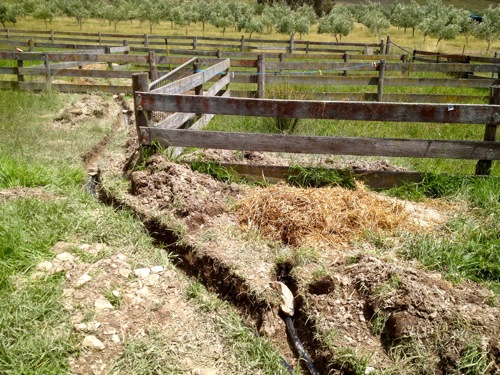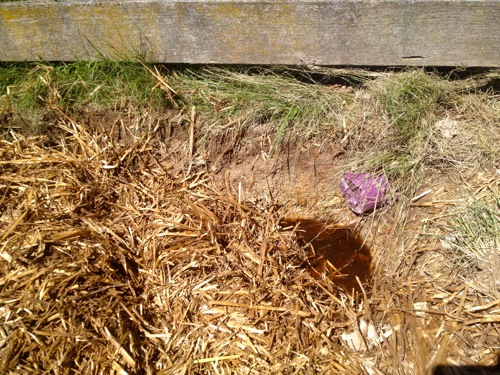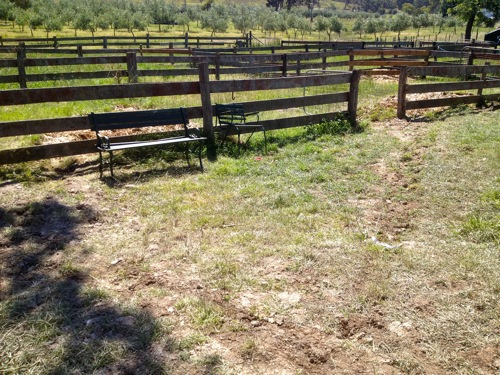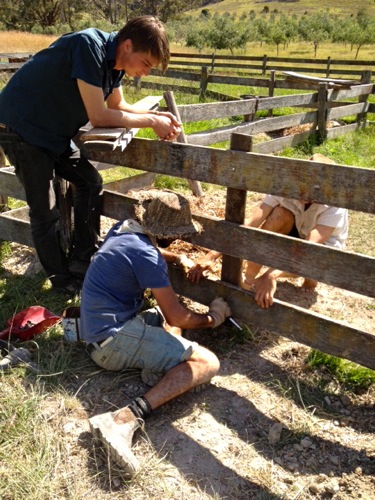
Greywater is a resource that can be awesome if capitalized upon, especially on a farm with unpredictable rainfall. We’ve just finished a simple greywater system that we’re pretty darn happy with.
Up at the woolshed we have two greywater sources: the washing machine, and the outside sink. Both these water sources provide pulses of water that could be helping grow a gorgeous living environment if used properly, so after a good deal of talking about it we finally did something…
To design this system we researched how to build a greywater system that was super simple, that could deal with pulses of water (rather than constant flow), and that would be appropriate for our needs.
The two main sources we used were:
> The fabulous Branched Greywater Systems and Creating an Oasis with Greywater by Art Ludwig
> The awesome Rainwater Harvesting for Drylands and Beyond set by Brad Lancaster
The design is pretty simple: multiple pipes at greywater source, each leading to the edge of one mulch pit. The greywater outlet is swapped between these separate pipes daily or weekly (depending on greywater load). Trees and plants are grown in or next to the mulch pit. And that’s it.
The bottleneck (literally as well as figuratively) with DIY greywater systems seems to be the question of how do you get water to multiple mulch pits. Art Ludwig has some great branched greywater solutions, but some of the pieces were hard to source in Australia.
The other factor is that greywater, by definition, sometimes has bits of gunk in it. And if there’s forks or connections in the pipe, that gunk can clog things up. Causing greywater system fail. Stinky and sad, all at once. Messy to fix, too.
So our solution was to avoid all joins and branches in this system. Each pipe is just that: one continuous pipe, end to end. 4 pipes at the greywater outlet end lead to 4 mulch pits, each with their own pipe.
Apart from ensuring a super simple, visually explainable system, this design also means that if one pipe gets blocked, the whole system doesn’t fail. Worst case scenario, we have to pull up one pipe, but that’s far better than having to chase down and take apart the whole system to find the problem.
So now we have the washing machine feeding 4 mulch pits, and the outside sink feeding 4 mulch pits.
Next step will be planting a range of beautiful shade trees (also useful of course, for people food, sheep food, bee food and biomass) and their associated guilds beneath.

The greywater outlet arrangement for the outside sink. White pipe (outlet from sink) is pulled out and switched to the next black pipe (which leads to a mulch pit) as regularly as needed
Big thanks to Art Ludwig and Brad Lancaster for providing such great info. Big thanks to Floyd Chris Constable for driving the project, and to the fabulous Milkwood Farm wwoofers Paul, Andrea, Michael, Pedro, Ashley, Sophie & Sharn for making it happen, and to Ashley for the great diagram.
Yay lastly to Nick for having the bright idea about the outlet pipe arrangement, and how to do it without needing taps and branches, no doubt saving us all from future ‘where the heck is the blockage’ joy…
Resources:

Paul, Michael and Andrea discussing the upsides of using hand tools (all power drills were in use on the tinyhouse that day)...























Brilliant!
Awesome. What a fantastic plan. Y’all are very kind to your offspring, ya know?
Hey that’s a great solution! I’ve got the beginnings of a similar system, but it was frustrating trying to find the branched Y fittings that Art Ludwig suggests, and tees just didn’t seem to cut it. I ended up just using a single pipe to a mulched trench (swale style), but I think I’ll add a second pipe now to a lower mulched trench.
What sized pipe did you use?
Hey Samantha, we used 1.5 inch ‘greenline’ ag polypipe… yeah we went with this design after not being able to source the ‘Y’ fittings also… good luck!
nice job, well done.
simple , servicable, trouble free.
useful trees
do you want some oaks to plant there?
beautiful shade in summer, sun in winter.
acorns for sheep, pig, chook fodder.
mushrooms for people food.
leaves for compost/garden
I have some Q.lobata and Q. macrocarpa ,
2nd yr seedlings if you want.
they need a good home.
I speedy,
would love some Oaks trees if you have any to spare. I have had no sucess in growing them.
Happy to pay.
Thanks
Stewie
Any chance the Oaks are inoculated with Truffles Speedy?
I would love some oaks I have a 80 acres up in the mountains 40 kms from taree
I like it. I’ve been trying to design a good way to use our grey water to supplement rainfall and grow some things like taro and water chestnuts in SW Sydney. As I read the article, another solution to the single source – multiple destination problem occurred to me. What if both grey water sources ran into a single filling bed which could, optionally, supply filtration, food or fodder via it’s plantings. This slightly sloping bed would then supply the grey water to the ag pipes set up at the bottom end of the bed, lined up next to each… Read more »
Thankyou for posting this. The property we have (not built by us) makes no use of the greywater, it literally runs down the mountain side, such a waste. This has, at least, given me a starting point for research.
yr welcome – do check out the resources above, they’re great stuff.
Nice work! Much infrastructure going in here at present for future rainwater / greywater / mains water input and distribution (for a future post). I love the simple elegance of this greywater solution though. One question – don’t little hands love hiding ‘treasures’ down all those inviting pipes?? I must get around to capping ours!
I would comment that you should not plant trees over the pipe as the root systems will squeeze the pipe and I did something similar but used a triple poly septic system tank where the pump is in the third tank so any solids are trapped in the two first tanks and clear grey water runs into the pump. One thing also might mention is that plumbing code requires that you use a “purple coloured” grey water system pipe instead of a rural pipe like you used. The reason is confusion of folks thinking that it is potable water. I… Read more »
yep we’ll be planting the trees on the down-side of the slope next tot he pit, or possibly (depending on species) in the pit, planted and arranged as per landcaster + ludwig’s diagrams… definitely a trick to it!
Good thought on sleeving the ends with purple, tho it would be very hard for someone to mistake the water in the pit for drinking water… especially as it’s submerged in mulch…
Looks good, we like the simple low tech ways of dealing with greywater, and would do this sort of thing with the house we are building, but the council is giving us such a hard time over our reedbed system. Seriously councils are the biggest hurdle for innovation and sustainable building/living….
I was wondering what the length is overall? And are you looking into harvesting what rainwater you do get as well?
I’m hoping to move back to the land in the next couple years and looking for a property in an area that doesn’t have a block on innovation and sustainable living is becoming a real challenge, but it is a major consideration.
Overall length is about 100m of pipe (that’s just my estimate, will cross-check that). All rainwater falling on all roofs around this farm is caught and stored in tanks – it’s our drinking water supply….
Nice one guys, I like the thinking Nick. Below is a link to another non branching mulch pit option I posted a while back that might suit some city folk. I had a few people tell me they were addictive after building their first one at a Permablitz. Cheers, Cam (http://permaculture.org.au/2009/05/20/greywater-mulch-pits/)
Hey Cam, yeah we love that design of yours… the main reason we varied from the one you outlined was that because the pipes have to cross a high-traffic pathway, we needed to put them underground for trip hazard reasons (which meant static pipe placement, rather than being able to move the central pipe around)… but in other contexts yours is the more elegant system – far less pipe! While yr here, have you ever planted trees directly into the mulch pit (tho raised up so as not to get the bark waterlogged, as per the various ludwig + lancaster… Read more »
Hi K. Definetely out of the pits, often a couple of metres away so that two or three trees have access. For young trees in this situation I dig a finger from the side of the main mulch pit towards the young tree to ensure water gets close to its toes from the beginning. They follow this moist finger out towards the main source pretty quickly. By the way, like Kirsten and Nick are doing, make sure you rotate around to various locations. Not only will you avoid water logging trees (I’d say the most common plant health problem associated… Read more »
We have a grey water system on our property. Our grey water system is regularly checked by a local council official. We are not connected to the local sewerage system – this grey water is clear and odourless but not safe for irrigating fruit trees or any edible plants. Is there a way that we can purify this water? I noticed one of the resources mentioned in our notes was very positive towards grey water but is an American article
Sarah if you mean to purify it enough to… drink? Then no i dont know of an easy DIY system for that… but when you say it’s ‘not safe’ for irrigating… is that something you’ve been told? I would think if it has been througha. decent greywater system then it would be a prime candidate for your fruit trees?